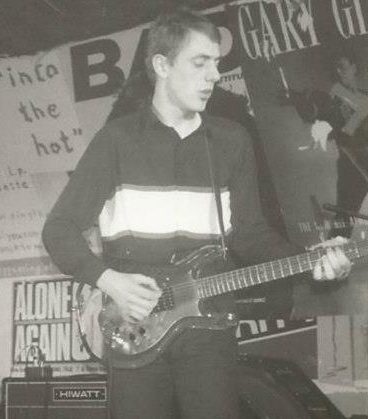The British folk scene of the 60’s and early 70’s may seem like a surprising influence on The Jasmine Minks. But I was immersed in it from a very young age. My sister, Sandra, is 8 years older than me and was more maternal than sister-like to me in many ways. As a young child we moved around a lot – we stayed in Jasmine Terrace at three locations and times were tough. At one point the two of us slept in a boiler room at the back of a hotel with a makeshift bed. I remember Sandra singing to me as I went to sleep – pop songs of the day – Groovy Kind Of Love and Simon and Garfunkel songs. She has a beautiful voice. She was going along to the burgeoning folk club scene (one in particular was in my Auntie Race’s place, Highland Hotel, just off Union Street in Aberdeen). Sandra would regularly take me along to folk clubs and festivals. The smaller clubs had fantastic musicians and singers who would just get up and sing unaccompanied (Sandra occasionally got up and sang) – and there is nothing more emotional than a lone singing voice. I can’t pretend that I liked all of the music she took me too – I was young and easily distracted and it took a while to get used to the music which was nothing like what I was used to hearing on BBC Radio 1. She tells the story of going to the Inverness folk festival where Martin Carthy, Christy Moore, Barbara Dickson, Billy Connolly and others were playing and Billy Connolly letting her and her pals sleep on his hotel room floor instead of spending another night freezing in a snow-covered campsite.
Sandra would buy and lend me records by Steeleye Span, Planxty, Nic Jones, Bert Jansch, Pentangle, Lindisfarne, The Humblebums, Magna Carta, Fairport Convention. Rock music had been around for a few years, so it wasn’t surprising that it was finding its way into folk music too with drums and electric guitars in some of the music, although the folk clubs were still strictly acoustic in my experience. Rock had changed drastically in those few years, from basic garage punk through to grand stadium rock with jazz and classical influences. But the back to basics attitude lived on in folk and folk-rock music – it might have been a bit more adult-oriented but it was still accessible music that sometimes grooved and rarely bred snobbery.
When Sandra was 16 and 17, she spent summers working and going to folk clubs in and around Harrogate, and soon moved to Newcastle-Upon-Tyne where she eventually studied French and Spanish. Every summer I would go and visit her and she would take me along to folk concerts and festivals. She started teaching me guitar – and the main picking style she taught me is the one that I still use to this day. Her boyfriend at that time, Steve, was an amazing guitarist and would pick away all day and sing in his Nick Drake style whisper – he would play at some of the folk clubs. I remember one night we went for dinner to a friend of hers, Stefan, who lived above the museum that was then in the castle keep near the railway and looking onto the Tyne Bridge. There were guitars, dulcimers and mandolins lying around – all made by Stefan – I was amazed that someone could be so talented to make these beautiful instruments. At home in Aberdeen, gradually, these tunes were becoming a part of me – they were never cool for a kid like the Glam Rock and Pop music that I mostly listened to, but I still loved them. Guitarists like Bert Jansch and Richard Thompson sounded amazing to me and it wasn’t until I’d been playing for years that I realised that they played hard and whacked those string to get those amazing sounds – they weren’t gentle guitar players by anyone’s standards.
You don’t need to go far to hear how the picking styles of those great guitarists have been emulated in Jasmine Minks songs. When Where The Traffic Goes single was released we did a busking tour of London with acoustic guitars proving that our songs worked without the amplified sound – songs like Work For Nothing, You Got Me Wrong, Summer Where, Reaching Out have guitar picking highlighted in them. By the 90’s, I was mainly listening to folk music, blues and electronic music. When me made Popartglory for Alan McGee’s Poptones record label, we were mixing rock, folk and electronica. Sandra sang the Blackwaterside melody solo and we added some pretty scary synths and beats to it.
I wouldn’t know where to start when choosing a song to accompany this blog. I love the guitar playing of John Martyn, Bert Jansch and Richard Thompson and the vocals of Jacqui McShee, Sandy Denny, Anne Briggs, Christy Moore and Maddy Prior to name a few. This song is one of my all-time favourites…


Fascinating to read this, Jim – and perhaps it goes a little way to explaining the timeless feel of many of the best Minks songs.
LikeLiked by 1 person
Thank you – just trying to show my influences from a more personal viewpoint.
LikeLike